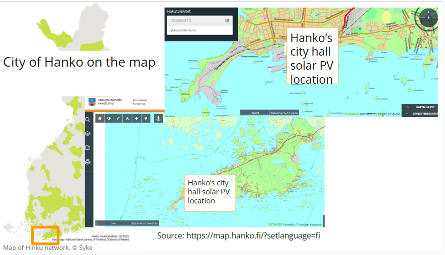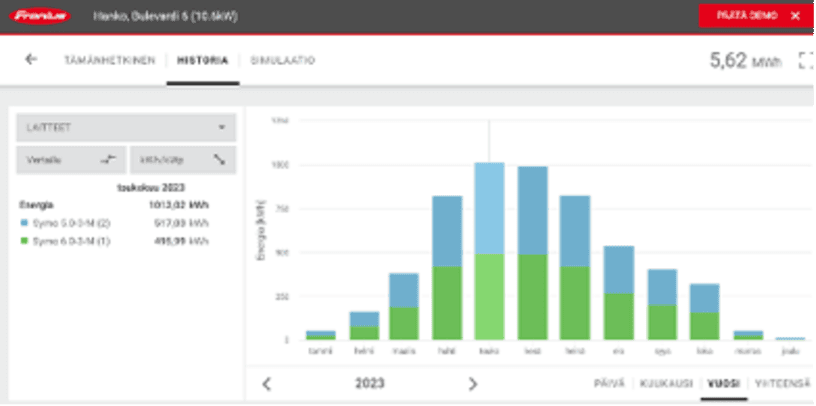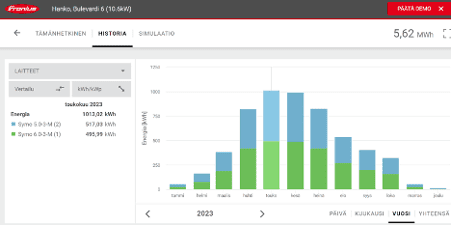
Case Study #3: Hanko (Finland)
04 October 2024
Author: Green Net Finland
Keywords: Public buildings, power purchase agreements
Overview
The city of Hanko is in the Southwestern region of Finland). In 2018, the city installed 12 solar power plants on its properties’ roofs and grounds. The combined power of the power plants is about 700 kilowatts. Hanko acquired part of its solar power plants through a joint procurement by the Finnish Environmental Institute SYKE and Municipal Procurement (original term in Finnish: Kuntahankinnat)
The regional electricity distribution company operating in Hanko’s area is Caruna Ltd.
The City of Hanko is part of the original group of municipalities known as “Hinku” municipalities, which have pledged to achieve an 80% reduction in emissions from 2007 levels by the year 2030.
“I became mayor of Hanko in 2015, and around the same time, SYKE launched a joint procurement for cities and municipalities to acquire solar power plants. Quite by chance, Forus was active in its sales work towards us at the same time,” Denis Strandell, Mayor of Hanko.
“From the beginning, I sold the idea to politicians by saying that this is financially very profitable but implemented in the long term. During the contract period, the economic value is +-0, but the emission reductions achieved can be counted for your own benefit from the very first day. Also, brand value, which cannot be directly measured in money, begins to develop from the first day.” Strandell says. Compared to other municipalities and cities, Hanko has been among the first to implement similar projects. “At least 15 representatives of different municipalities and cities have visited our project and financing solutions.”
“The majority of people in Hanko are proud that the city is a pioneer in this way. When the solar power plants were built, no city had built solar energy production on the same scale. Our project has been a common source of pride and attracted positive attention,” says Strandell.4
Legal form
The power plants are financed with a 12-year leasing agreement, where the charge corresponds to the value of the electricity produced by the power plants when purchased from the grid. After this, the panels become the property of the city and produce free energy for another 30 years.5 The solar power plants were supplied by company GreenEnergy Finland. After the 12-year contract, the annual savings are estimated at 63,000 euro. The city acquired another part of the solar panels through the companies Forus Capital Ltd. and Valoe. The city committed to buy the electricity produced by the power plants at a price even slightly lower than the market price for 10–15 years, depending on the price of electricity. Once the repayment is completed, the panels become the property of the city.6
Technological setup
The latest twelfth power plant was installed in 2021. However, there is still more to come.
“We have a few large solar power projects going on, up to ten times as many as we have at the moment. In the future, we also hope to be able to transfer solar electricity from one property to another if the need arises,”says mayor Strandell.8
12 separate solar power plants are operating in Hanko, most of which are on the roofs of the city’s properties. The combined power of the power plants is about 700 kilowatts. Panels can be seen, for example, on the roofs of kindergartens, schools and the city hall.
“The energy produced by the power plants is used in the properties on whose roofs they are installed. At best, the power plants produce 20 percent of the site’s total electricity consumption. In most cases, it is difficult to reach figures better than this. For example, schools are problematic, because they use the most electricity in the winter, and solar panels produce the most energy in the summer when consumption in schools is the lowest,” Hanko Mayor Denis Strandell sums up.
Governance
As already described in the previous chapters, the mayor of the City of Hanko had the role of driver of the case. In this Hanko municipality/city case, the solar PV power plants are implemented via leasing contract. The city handles procurement process as joint procurement.
Forus Oy offers municipalities an electricity purchase agreement from the solar power plants they have installed. Hanko undertakes to buy the electricity produced by the solar power plants from the company until the investment in the power plants is covered. After this, the panels become the property of the city.9
One of the members of Hanko’s EC is a regional electricity distribution company, Caruna Ltd.
Facts about Caruna Ltd.
- Caruna started as an independent company when Fortum Ltd. gave up its Finnish electricity distribution business in 2014.
- The company includes two different distribution companies: Caruna Espoo Oy, operating mainly in urban conditions (Espoo, Kauniainen, Kirkkonummi and the centre of Joensuu), and Caruna Oy, mainly in rural areas (Western Finland, Central Uusimaa, Western Uusimaa, Southwest Finland, Satakunta, Southern, Central and Northern Ostrobothnia, and Koillismaa).
- Distributing electricity to 732,000 customers equalling 20% of Finnish electricity distribution.
- Caruna is owned by global investment firm KKR (40%), Ontario Teachers pension plan (40%), Swedish AMF Pension (12.5%) and the Finnish pension insurance company Elo (7.5%).10
- Valoe Ltd. has had a role of solar PV technology provider to the case. Now of writing this report, the company is undergoing a process of restructuring.11
Business model
The normal purchase price for the panels installed on the roof of Haagapuisto school alone would be around 100,000 euro. Valoe Ltd., the solar panel manufacturer from Mikkeli (the City of Mikkeli is in the eastern central part of Finland, in South-Savo region), predicts that the prices of the devices will drop a little more.
“The price has dropped by about half in recent years, and many certainly assume that the decline will continue. I don’t believe in the same pace anymore, but I don’t believe in price increases either”, Valoe Ltd.’s CEO Iikka Savisalo points out.12
In search of the perfect funding model, Power Purchase Agreements (PPAs) were used to finance their solar power plants. PPAs are contracts for renewable energy that are gaining popularity among large companies, small and medium-sized enterprises (SMEs), and local governments. They offer a dependable method for reducing carbon emissions by switching to renewable electricity sources, thus aiding in the transition to cleaner energy. Typically, a significant electricity user or a group of smaller users agrees to buy a set amount of electricity from a producer for a fixed price for 10 to 20 years.
In the case of Hanko city, they financed their solar power plants through a 12-year leasing agreement, where they pay based on the electricity’s value produced by the plants compared to the grid price. Once this agreement ends, the city gains ownership of the panels, which continue to generate free energy for another 30 years. The solar panels were provided by GreenEnergy Finland. Upon the 12-year contract’s conclusion, the city expects annual savings of 63,000 euro. Additionally, some solar panels were obtained through Forus Capital Ltd. and Valoe. The city has committed to purchasing electricity from these plants at a slightly lower price than the market rate for 10 to 15 years. Once the repayment is completed, ownership of the panels transfers to the city.
Municipalities and organizations (> 50 % owned by municipalities) could participate in joint procurement until the end of 2020.13
Digital tools
Detailed information about performance of the solar PV: s is available online [6]. From the links below, you can follow the yield of the solar power plants located in different buildings in the city:
References:
Caruna. 2023. “Hanko Suunnannäyttäjä Kuntien Aurinkosähkön Käytössä – Paneelit Tuottavat Parhaimmillaan.” Caruna.fi. https://caruna.fi/ajankohtaista/hanko-suunnannayttaja-kuntien-aurinkosahkon-kaytossa-paneelit-tuottavat-parhaimmillaan. Accessed on 21.2.2024.
Caruna. 2023. “Hanko Suunnannäyttäjä Kuntien Aurinkosähkön Käytössä – Paneelit Tuottavat Parhaimmillaan.” Caruna.fi. https://caruna.fi/ajankohtaista/hanko-suunnannayttaja-kuntien-aurinkosahkon-kaytossa-paneelit-tuottavat-parhaimmillaan. Accessed on 21.2.2024.
Forus. 2023. “Asiakastarina: Hangon Kaupunki.” Forus.fi. https://www.forus.fi/en/ajankohtaista/asiakastarina-hangon-kaupunki/. Accessed on 22.2.2024
Kestavyysloikka. 2023. “Hangon Kaupunki Palkittiin Kaupungille 12 Aurinkovoimalaa.” Ympäristö.fi. https://kestavyysloikka.ymparisto.fi/hangon-kaupunki-palkittiin-kaupungille-12-aurinkovoimalaa/ Accessed on 21.2.2024
Uudenmaan Liitto. 2021. “Energiaa Auringosta: Vinkkejä Teollisen Mittakaavan Aurinkoenergian Tuotantoon Uudellamaalla.” Uudenmaan Liitto. https://uudenmaanliitto.fi/wp-content/uploads/2021/11/Energiaa-auringosta-esite.pdf. Accessed on 22.2.2024
Valoe. 2023. “Valoe – Solar Cell Technology and Manufacturing.” Valoe.com. https://valoe.com/. Accessed on 1.3.2024
Wikipedia. 2023. “Caruna.” Wikipedia, the Free Encyclopedia. https://fi.wikipedia.org/wiki/Caruna. Accessed on 1.3.2024
Yle. 2018. “Hanko Ottaa Jättiloikan Aurinkosähkön Käytössä: ‘Näytämme Vähän Tietä Muulle Suomelle.‘” Yle.fi. https://yle.fi/a/3-10165128. Accessed on 1.3.2024









